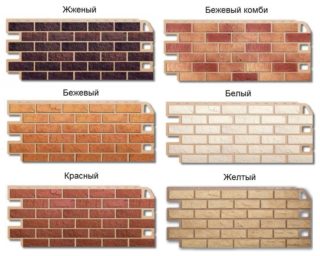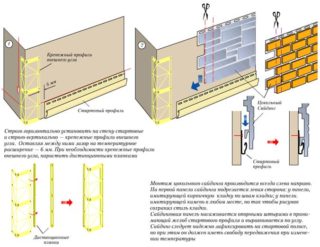The part of the foundation protruding above the ground (basement) experiences high pressure loads and is exposed to the external environment. Moisture, dirt, frost, mechanical stress lead to deterioration of the structure, negatively affect its appearance, which is far from being indifferent to the owners of real estate. The best type of protection for the support system is a basement siding for a brick. This type of coating is able to effectively resist external factors, but also become a real decoration of the building. There are various types of decorative bricks for the basement, each of which has its own characteristics, advantages and disadvantages.
Definition of basement siding
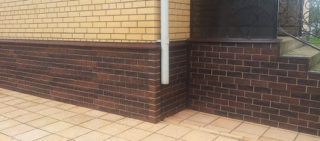
The basement brick is a finishing material for facade work. It is produced in the form of tiles and panels of various sizes and configurations. Fastening is done on glue or frame.
The brick for the basement plinth consists of two layers:
- Interior. It is a durable substance with significant strength, and in some models - and thermal insulation properties. Provides protection of the base from mechanical damage.
- External. Performs a decorative function, insulates the base of bricks from moisture and chemically active reagents. The coating can imitate natural stone, red brick, facade plaster and other materials that are used to decorate buildings.
A high-quality brick plinth is made from environmentally friendly raw materials that do not harm human health and the environment.
Features of basement brick siding
Basement brick siding has a wide range of applications. This facing material is used not only for decorating the part of the support system protruding from the ground. It is perfect for finishing balconies, loggias, verandas and terraces. Panels also look great indoors - in corridors, halls, kitchens, bathrooms, living rooms and even bedrooms. This type of cladding is no less popular among the heads of public institutions. Siding is used in the decoration of offices, salons, entertainment venues and catering establishments.
When choosing a product for external work, it is necessary to take into account a number of criteria that determine the effectiveness of its work.
Basic requirements for finishing the basement of a brick house:
- strength;
- durability;
- wear resistance;
- appearance;
- waterproofness;
- low coefficient of thermal expansion;
- frost resistance.
The choice of material is determined by the purpose and features of the operation of the building, where the criteria are its shrinkage, climate and human factor.
Varieties of brick siding and characteristics
- Metallic. The raw materials are iron, aluminum, zinc. Installation is carried out on a clamping, suspended or blind (bolted) type frame. The advantage of the material is its affordable cost and the absence of wet processes during installation. The downside is that the panels are easy to bend even with little effort, and such a defect cannot be repaired. Rust quickly develops at the site of scratches on iron siding.
- Vinyl.The basis of the tile is a modern plastic, polyvinyl chloride. The material is characterized by ductility, flexibility and elasticity, along with strength and wear resistance. Fastening is carried out on an adhesive, taking into account the thermal expansion of plastic.
- Cement. The panels are made from a mixture of the M200 grade with the addition of synthetic fibers that perform the function of reinforcement and decoration. The tile is characterized by high strength, low coefficient of thermal expansion and ease of installation.
- Basement. Clay brick with a thickness reduced to 5 cm is used. It is used for finishing a basement made of concrete or sand-lime bricks, when it is necessary to simultaneously solve the problem of finishing and insulating it.
Siding is subdivided according to the surface texture - matte and glossy, smooth and textured. Edges are edged and unedged.
What to choose for the base of the foundation
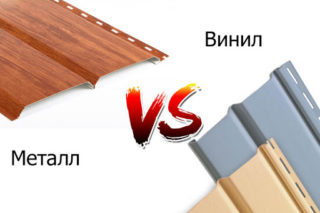
As practice shows, polypropylene is considered the best option. The material meets almost all the requirements for exterior decoration at an affordable cost.
When it comes to strength, there is no equal to clay brick. The best proven clinker type products, consisting of two durable ceramic layers and having excellent thermal insulation properties. Fireclay brick is the strongest, but its appearance requires improvement. This is followed by the solid red brick used in the construction of the walls. This finish looks presentable, but over time it begins to crumble.
You can choose a metal, but only with full confidence that no one will damage it on purpose or by negligence.
Advantages and disadvantages of brick basement siding
You should find the optimal balance between the pros and cons of a basement brick.
This type of finish has the following advantages:
- presentability;
- practicality;
- long service life;
- applicability to all types of buildings and premises;
- affordable cost;
- a wide range of products;
- ease of care and maintenance;
- the ability to do it yourself.
Metal bends easily, iron rusts. Clinker is fragile, and clay products do not tolerate moisture changes. Polymer panels expand strongly when heated, leaving chips and scratches on them after contact with hard objects.
Calculation of the amount of material
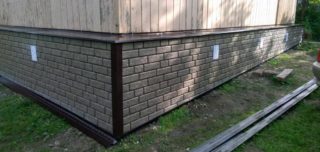
With the correct calculation, a minimum amount of waste remains, which has a positive effect on the construction budget. It is necessary to consider the issue of possible damage to fragments of masonry and their replacement. Therefore, you need to take finishing bricks with a small margin in order to have at your disposal several whole tiles or panels.
Determining how much material is needed is not difficult. The total area of the base is measured and divided by the area of one fragment. In this case, it should be borne in mind that the tile lays down in a checkerboard pattern, it is possible that the trims cannot be reused.
Substrate preparation and installation
- clean the base from dust and dirt;
- level the surface with cement mortar;
- treat the base with a deep penetration primer.
Panel mounting:
- assemble the frame, if provided by the assembly technology;
- install a plinth strip for tiles;
- lay out the first row below or fix the panels on the frame;
- arrange corners;
- bring the masonry to the top, constantly controlling its horizontal.
In conclusion, the strength of the fastening of the tiles is checked and expansion joints are sealed.

